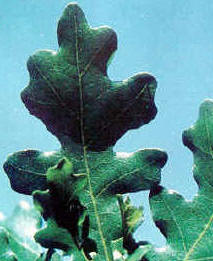 Cattle, sheep and occasionally horses can be poisoned by browsing on oak. Shinnery oak (Quercus havardii) and Gambel (Q. gambelii) oak are the species responsible for most losses. Shinnery oak, or shinnery, is common in the Southwest. Gambel oak, also called scrub oak, is found throughout the central part of the western states. Scrub oak may be a shrub 1.0-1.5 meters high or a tree up to 10 meters high. Shinnery oak grows 0.5-1.0 meters high. Cattle, sheep and occasionally horses can be poisoned by browsing on oak. Shinnery oak (Quercus havardii) and Gambel (Q. gambelii) oak are the species responsible for most losses. Shinnery oak, or shinnery, is common in the Southwest. Gambel oak, also called scrub oak, is found throughout the central part of the western states. Scrub oak may be a shrub 1.0-1.5 meters high or a tree up to 10 meters high. Shinnery oak grows 0.5-1.0 meters high.Poisoning is caused by young oak browse, sprouts in cutover areas, mature foliage on felled trees, acorns, and fallen leaves. Oak is most dangerous in the budding and leafing stages and when acorns are available. As leaves mature, oak decreases in toxicity. Cattle may get as much as 50 percent of their diet from oak browse without showing signs of poisoning. More than 50 percent of oak browse in the diet will cause sickness, and more than 75 percent will cause death. The toxic substances are thought to be oak tannins. Oak leaves are leathery and deeply lobed, with wavy margins. Acorns form at base of stems (lower center). Oak is a woody perennial. Where and When It Grows
Shinnery oak is a low, spreading shrub that grows in sandy areas. It is found primarily in western Oklahoma, western Texas, and eastern New Mexico. Gambel oak is a shrub or small tree. It grows in dense thickets on foothills and mountain slopes, up to an elevation of 9000 feet. Oak usually starts growing in early spring before other range plants. How It Affects Livestock
Oak toxins are incompletely identified, but are most likely a gallotannin or a combination of gallic acid and tannic acid. Buds, small leaves and flowers are most palatable and most often associated with livestock poisoning. Poisoning can occur later in the fall and winter when acorns are available. There are anecdotal reports of poisoning when cattle drink water that has soaked oak leaves. Poisoning results in severe enterogastritis and nephrosis. Death from oak poisoning may occur in a few days to 2 weeks after the cattle first show signs. Signs and Lesions of Poisoning Lack of appetite Gaunt, tucked-up appearance Constipation, frequently followed by profuse diarrhea Weakness Rough dry hair coat; dry muzzle Tendency to remain near water, excessive thirst Reluctance to follow the herd Emaciation Mucus in droppings Frequent urination; dark-colored urine Edema: swelling under the jaw and brisket and
ascites Subnormal temperature Collapse Death Gastritis: abomasum and small intestine inflamed Swollen kidneys Nephrosis: renal tubular necrosis with tubular hyaline casts Uremia How to Reduce Losses
Livestock losses from oak poisoning can be reduced by conservative grazing and proper seasonal use of shinnery and Gambel oak ranges. In shinnery areas of the Southwest, livestock owners should reserve pastures with the least amount of oak for early spring grazing. The use of supplemental feed containing 10% calcium hydroxide will help reduce losses. In Gambel oak areas, animals should be kept off oak ranges until other forage becomes available and the oak leaves mature. At first signs of poisoning, remove the affected animals from the herd and give them adequate feed and water. In some cases, the use of a mild laxative, such as mineral oil, may be beneficial. Oak can be controlled with tebuthiuron at 0.25- 05 kg ai/Ac applied to the soil in winter. Follow all precautions for handling herbicides. |

 Cattle, sheep and occasionally horses can be poisoned by browsing on oak. Shinnery oak (Quercus havardii) and Gambel (Q. gambelii) oak are the species responsible for most losses. Shinnery oak, or shinnery, is common in the Southwest. Gambel oak, also called scrub oak, is found throughout the central part of the western states. Scrub oak may be a shrub 1.0-1.5 meters high or a tree up to 10 meters high. Shinnery oak grows 0.5-1.0 meters high.
Cattle, sheep and occasionally horses can be poisoned by browsing on oak. Shinnery oak (Quercus havardii) and Gambel (Q. gambelii) oak are the species responsible for most losses. Shinnery oak, or shinnery, is common in the Southwest. Gambel oak, also called scrub oak, is found throughout the central part of the western states. Scrub oak may be a shrub 1.0-1.5 meters high or a tree up to 10 meters high. Shinnery oak grows 0.5-1.0 meters high.

